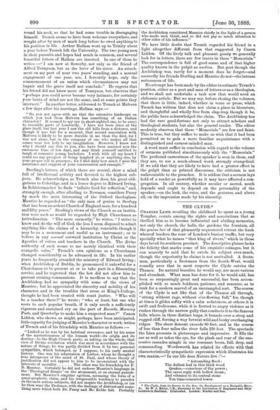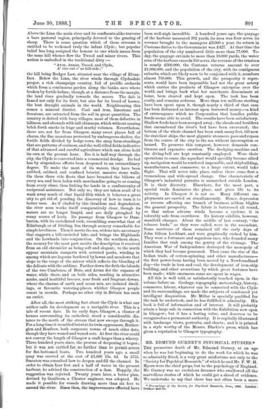THE CLYDE.*
CHARLES LAMB, recalling the childhood he spent as a young Templar, counts among the sights and associations that so thrilled him as to become influential and abiding memories, not only the church, the halls, the gardens, the fountain, all the genius loci of that pleasantly sequestered retreat the hush whereof borders the roar of London's busiest traffic, but very specially what he names "that king of rivers," which in those days laved its southern precinct. The descriptive phrase lacks the felicity that marks some of his exquisite coinages, but it can scarcely be said that he extols its subject over-much, though the superiority he claims is not unrivalled. A Scots- man, particularly a Scotsman from the South-West, would roundly aver that in most respects the Clyde outvies the Thames. Its natural beauties, he would say, are more various and abundant. What man has done for it, he would add, has been so surpassingly great and successful, has been accom-
plished with so much boldness, patience, and resource, as to rank for a modern marvel of an unexampled sort. The course of the Clyde is not like that of the Thames all through, "strong without rage, without o'er-flowing full," for, though at times it glides softly with a calm sedateness, at others it is swift and frolicsome, while it is fretted to angry violence as it rushes through the narrow gully that conducts it to the famous falls, where, in three distinct leaps, it bounds over a steep and rugged cliff, forcing a way betwixt wild and bosky overhanging ridges. The sheer descent exceeds 80 feet, and in the course of less than four miles the river falls 230 feet. The spectacle the Linn presents is picturesque and impressive. It fills the
ear as well as takes the eye, for the plash and roar of the suc- cessive cascades mingle in one resonant boom, full, deep, and commanding. Wordsworth has related its effects with that characteristically sympathetic expression which illustrates his own maxim,—" In our life does Nature live :"—
" Astounding flood :
The dullest leaf in this thick wood
Quakes,—conscious of thy power ; The caves reply with hollow moan ; And vibrates to its central stone You time-cemented tower.
* The Clyde, from its Source to the Sea : its Development as a Navigable River, Sc. By W. J. Miller, C.R., Secretary to the Institution of Engineers and Ship. builders in Scotland. Illustrated. London: Mackie and Son.
Above the Linn the main river and its confluents alike traverse a bare pastoral region, principally devoted to the grazing of sheep. There is some question which of these streams is entitled to be reckoned truly the infant Clyde; but popular belief has long assigned the honour to one which issues from the same hill whence flow the Tweed and minor rivers. This notion is embodied in the traditional ditty Avon, Annan, Tweed, and Clyde, A' rise out o' ae hill-side ;" the hill being Rodger Law, situated near the village of Elvan.- foot. Below the Linn, the river winds through Clydesdale proper, a rich champaign country, full of prolific orchards which form a continuous garden along the banks, save where broken by fertile holms ; though, at a distance from the margin, the land rises gradually towards the moors. The dale is famed not only for its fruit, but also for its breed of horses, the best draught animals in the world. Neighbouring this comes a mineral district. Coal and iron, limestone and freestone, are extracted from the soil in great quantities. The country is dotted with busy villages, most of them defective in tidiness, and abounds with tall chimneys, which without ceasing belch forth smoke in huge and murky volumes. Nevertheless, there are, not far from Glasgow, many sweet places full of charm, the fine mansions protected by umbrageous shelter, the fertile fields divided by hedge-rows, the snug farm-stea.dings that are patterns of coziness, and the well-tilled fields indicative of that advanced and careful agriculture which can alone hold its own at the present hour. Ere it is half-way through the city, the Clyde is converted into a commercial drudge. Its bed has by stupendous efforts been deepened to an extraordinary degree. To make the most of its waters, they have been cribbed, cabined, and confined betwixt massive stone walls. On them there ride fleets that have breasted the billows of every sea, and been laden with merchandise going to or coming from every clime, thus linking far lands in a confraternity of reciprocal assistance. Not only so ; they are taken avail of to wash away much of that liquid filth which it behoves a great city to get rid of, pending the discovery of how to turn it to better uses. As if chafed by this thraldom and degradation, the river soon works itself comparatively clear, though its waters are no longer limpid, and are daily ploughed by many scores of keels. Its passage from Glasgow to Dum- barton, with its castellated rock, resembling somewhat that of Edinburgh or of Stirling, lies through scenery remarkable for simple loveliness. Then it meets the sea, widens into an estuary that suggests a hill-encircled lake, and brings the Highlands and the Lowlands into conjunction. On the southern shore, the scenery for the most part merits the description it received from an old chronicler as being soft and elegant; to the north appear mountain ramparts with serrated peaks, winding in among which are lagoons bordered by lawns and meadows that slope to the verge of the mirror which reflects the blending of the delicate with the sublime. Farther down the firth the islands of the two Cumbraes, of Bute, and Arran dot the expanse of water, while there, and on both sides, nestling in attractive nooks, amid healthful breezes, near fresh and fragrant downs, where the charms of earth and ocean mix, are isolated dwell- ings, or favourite watering-places, whither Glasgow people resort in crowds. Perhaps no other city in Britain has such an outlet.
After all, the most striking fact about the Clyde is what our author calls its development as a navigable river. This is a tale of recent date. In its early days, Glasgow, a cluster of houses surrounding its cathedral, stood a considerable dis- tance to the north of the stream that now sweeps through it. For a long time it trembled betwixt its twin-oppressors, Ruther- glen and Renfrew, both corporate towns of much older date, though they have waned and waxed sere. At first the river could not convey the length of Glasgow a craft larger than a wherry. Three hundred years since, the process of deepening it began;
but it was not carried far, no farther than to permit access
for flat-bottomed boats. Two hundred years ago, a small quay was erected at the cost of 21,666 13s. 4d. In 1755, Smeaton was consulted how to deepen and fill the channel. In order to obtain four feet and a half of water in the present harbour, he advised the construction of a dam. Happily, the suggestion was rejected. Twenty years later, a better plan, devised by Goulborn, a Chester engineer, was adopted. He made it possible for vessels drawing more than six feet to ascend the river. Since then, the improvements effected have been well-nigh incredible. A hundred years ago, the quayage of the harbour measured 382 yards, its area was four acres, its revenue brought to the managers 23,000 a year, its return in Customs duties to the Government was £427. At that time the population of the city numbered little more than 77,000. To- day, the quayage extends to more than 10,000 yards, the water area of the harbour exceeds 150 acres, the revenue of the trustees is nearly 2300,000, the Customs returns amount to over 21,000,000, and the population of the city, with its contiguous suburbs, which are likely soon to be conjoined with it, numbers almost 750,000. This growth, and the prosperity it repre- sents, would have been impossible had not the great artery which carries the products of Glasgow enterprise over the world, and brings back what her merchants disseminate at home, been cleared and kept open. The task has been costly, and remains arduous. More than ten millions sterling have been spent upon it, though nearly a third of that sun. has been disbursed as interest upon borrowed money,—a. kind of extravagance which no Corporation that handles public funds seems able to avoid. The results have been satisfactory. Shallow fords have been scooped away ; the shoals and boulders that encumbered the river's bed have been excavated; the bottom of the whole channel has been sunk many feet, till now the stateliest ships, the most gigantic steamers, pass and repass from the centre of the city to the sea without interruption or hazard. To preserve this conquest, however, demands con- tinuous and expensive exertion. The dredging-machine and the diving-bell are kept constantly employed. Were their operations to cease, the aqueduct would speedily become silted up, navigation would be rendered impossible, and shipbuilding, manufactures, and commerce, to a large extent, would take flight. That will never take place, unless there come first a tremendous and wide-spread change. One characteristic of Glasgow's industrial pursuits is unmatched outside London. It is their diversity. Elsewhere, for the most part, a special trade dominates the place, and gives life to its activity. In Glasgow it is not so. Many different em- ployments are carried on simultaneously. Hence, depression or reverse affecting one branch of business seldom blights the general prosperity. The fabric is buttressed all round, so that unless adverse winds become a cyclone, it is tolerably safe from overthrow. Its history exhibits, however, manifold changes. About the middle of last century, "the tobacco lords," as they were called, were in the ascendant. Some survivors of them remained till the early days of John Gilson Lockhart, and were graphically etched by him. They were a fortunate and sagacious race, who founded many families that rank among the gentry of the vicinage. The American War of Independence destroyed the monopoly of which they had become possessed. Then came the rise of the- Indian trade, of cotton-spinning, and other manufactures— the first power-loom having been moved by a Newfoundland dog—the trade in iron and coal, the development of iron-ship. building, and other avocations by which great fortunes have been made; while enormous sums are spent in wages.
All this is well told, or satisfactorily touched upon, in the volume before us. Geology, topography, meteorology, history, commerce, labour, whatever can be connected with the Clyde and its surroundings, are made the subjects of condensed yet intelligent disquisition. Mr. Millar is specially qualified for the task he undertook, and he has fulfilled it admirably. His book is full of information and of interest. It will probably attain a large sale in connection with the Exhibition now open in Glasgow ; but it has a lasting value, and deserves to be recognised as a permanent authority. It is capitally illustrated with landscape views, portraits, and charts ; and it is printed in a style worthy of the Messrs. Blackie's press, which has given a reputation to Glasgow typography.



















































 Previous page
Previous page